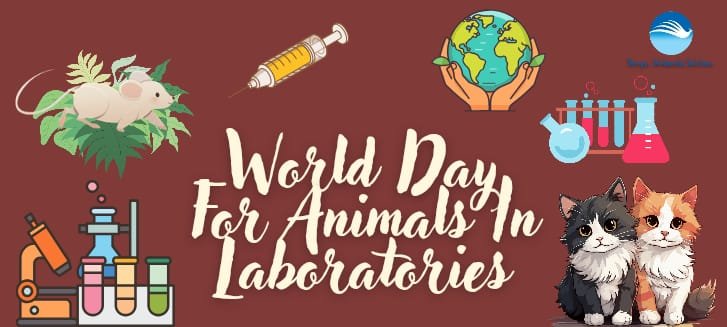By Sujata Muguda, Shreyas WebMedia Solutions
24/4/2024:World Day for Laboratory Animals is observed on April 24. There are millions of animals utilized in research facilities worldwide, and this international day serves as a sobering reminder of that fact. On this day, we honor their contributions to science and promote the reduction and eventually substitution of more compassionate methods for animal experimentation.
The history of World Day for Laboratory Animals stretches back to 1979, established by the National Anti-Vivisection Society (NAVS). The date, April 24th, holds significance as the birthday of Lord Hugh Dowding, a prominent advocate for animal welfare. Since then, the day has become a focal point for raising public awareness and fostering discussions about the ethical implications of animal research.
Animals used in laboratories encompass a wide range of species, including mice, rats, rabbits, dogs, non-human primates, and fish. They are subjected to a variety of procedures depending on the research goals. These procedures can range from non-invasive testing to more complex surgeries and the administration of potentially harmful substances.
The debate surrounding animal testing is complex. Proponents argue that animal models have played a vital role in medical breakthroughs, from the development of vaccines and antibiotics to advancements in understanding and treating diseases like cancer and diabetes. Animal research allows scientists to study biological processes in living organisms with a level of complexity that cell cultures or computer models cannot yet replicate.
Opponents, on the other hand, highlight the ethical concerns associated with animal testing. They argue that animals experience pain and suffering during procedures and that the results obtained from animal studies may not always translate accurately to humans due to physiological and genetic differences. They advocate for the development and implementation of more sophisticated non-animal testing methods.
The good news is that the scientific community is actively exploring alternatives to animal testing. These alternatives include:
- Cell cultures and tissue engineering: Growing human cells in a laboratory setting allows for the study of cellular processes and the testing of potential drugs.
- Computer modeling and simulation: Advanced computer models can be used to simulate biological systems and predict potential outcomes.
- Microdosing: This involves administering very low doses of a potential drug to human volunteers to assess its safety profile before larger-scale trials.
While these alternatives hold immense promise, they are not a one-size-fits-all solution. Replacing animal testing entirely will likely be a gradual process, requiring continued investment in research and development of these non-animal methods.
Some ways you can get involved in the World Day for Laboratory Animals movement:
- Educate yourself: Learn more about animal testing and the ongoing efforts to develop alternatives.
- Support animal rights organizations: Several organizations work to promote humane research practices and advocate for the welfare of laboratory animals. Consider donating or volunteering your time.
- Make informed choices: Look for products that haven’t been tested on animals. Many companies are increasingly opting for cruelty-free practices.
- Spread awareness: Talk to friends and family about World Day for Laboratory Animals and the importance of considering alternatives to animal testing.
World Day for Laboratory Animals is a day to acknowledge the sacrifices made by animals in scientific research. It’s also a call to action, urging us to support the development of more humane alternatives and promote responsible research practices. By working together, we can strive for a future where scientific progress doesn’t come at the cost of animal suffering.
